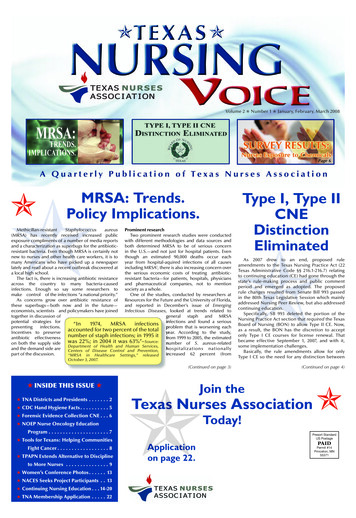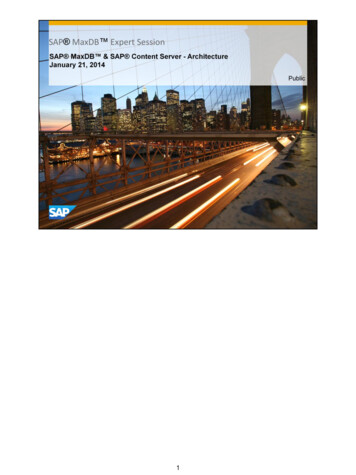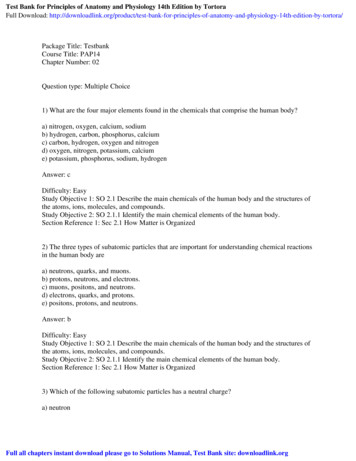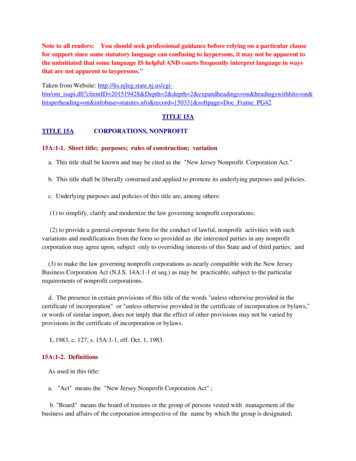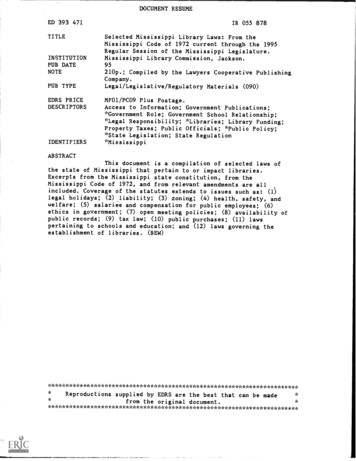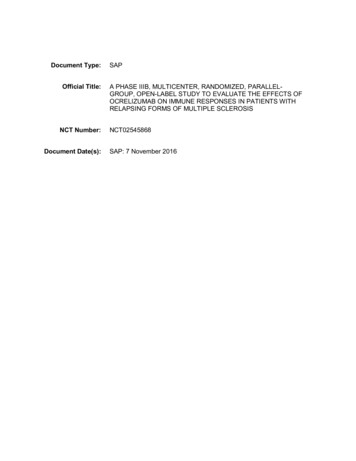
Transcription
Document Type:Official Title:NCT Number:Document Date(s):SAPA PHASE IIIB, MULTICENTER, RANDOMIZED, PARALLELGROUP, OPEN-LABEL STUDY TO EVALUATE THE EFFECTS OFOCRELIZUMAB ON IMMUNE RESPONSES IN PATIENTS WITHRELAPSING FORMS OF MULTIPLE SCLEROSISNCT02545868SAP: 7 November 2016
TABLE OF CONTENTS1.BACKGROUND . 62.STUDY DESIGN . 63.2.1Protocol Synopsis. 72.2Outcome Measures . 72.2.1Primary Immunization Outcome Measure. 72.2.2Secondary Outcome Measures . 72.2.3Immunophenotyping Outcome Measures . 82.2.4Safety Outcome Measures . 92.3Determination of Sample Size . 92.4Analysis Timing . 9STUDY CONDUCT . 93.14.Randomization Issues . 9STATISTICAL METHODS . 104.1Analysis Populations . 104.1.1Intent-to-Treat Population . 104.1.2Observed Cases Population . 104.1.3Safety Population . 104.2Analysis of Study Conduct. 114.3Analysis of Treatment Group Comparability . 114.3.1Demography . 124.3.2Multiple Sclerosis Disease History. 124.3.3Previous and Concomitant Diseases Other thanMultiple Sclerosis. 124.3.4Previous and Concomitant Treatments . 134.3.5Passive Immunization History and VaccinationHistory . 134.3.6Expanded Disability Status Scale . 144.3.7Pre-Vaccination/Pre-Immunization ImmunologyAssessments . 144.3.8Baseline Magnetic Resonance Imaging Data . 154.4Outcome Analysis. 16Ocrelizumab—F. Hoffmann-La Roche Ltd2/Statistical Analysis Plan BN29739Clinical Study Report: ocrelizumab - F. Hoffmann-La Roche LtdProtocol BN29739 Report Number 10793372122
4.4.1Primary Immunology Endpoint. 164.4.2Secondary Immunology Endpoints . 174.4.2.1Tetanus Toxoid Adsorbed Vaccine ResponseMeasured 4 weeks after Vaccine Administration . 174.4.2.223-Valent Pneumococcal PolysaccharideVaccine and Pneumococcal Conjugate Booster. 184.4.2.3Keyhole Limpet Hemocyanin . 204.4.2.4Influenza Vaccine Response . 204.4.3Other Secondary Endpoints (MagneticResonance Imaging) . 214.4.4Exploratory Immunology Endpoints . 214.4.4.1Overall Antibody Response to 23-PPV Vaccine . 214.4.4.2Overall Antibody Response to 13-PCV Vaccine . 224.4.5Sensitivity Analyses . 224.4.6Subgroup Analyses . 224.5Immunophenotyping Analyses . 224.6Safety Analyses. 234.6.1Exposure to Study Medication (Ocrelizumab). 234.6.1.1Exposure to Ocrelizumab during the ISP. 234.6.1.2Exposure to Ocrelizumab during the OOE. 244.6.2Adverse Events . 254.6.2.1Adverse Events during the ISP. 254.6.2.2Adverse Events during the OOE. 274.6.2.3Adverse Events, All Study Periods . 274.6.3Selected Adverse Events. 284.6.3.1Progressive Multifocal Leukoencephalopathy. 284.6.3.2Infections and Serious Infections. 284.6.3.3Infusion-Related Reactions. 284.6.3.4Malignancies and Premalignant Lesions . 304.6.4Laboratory Data. 304.6.4.1General Laboratory Evaluation . 304.6.4.2Anti-Drug Antibodies. 314.6.5Vital Signs and Electrocardiogram. 314.6.6Pregnancies. 32Ocrelizumab—F. Hoffmann-La Roche Ltd3/Statistical Analysis Plan BN29739Clinical Study Report: ocrelizumab - F. Hoffmann-La Roche LtdProtocol BN29739 Report Number 10793372123
4.7Missing Data. 324.8Interim Analyses . 32LIST OF APPENDICESAppendix 1Protocol Synopsis . 33Ocrelizumab—F. Hoffmann-La Roche Ltd4/Statistical Analysis Plan BN29739Clinical Study Report: ocrelizumab - F. Hoffmann-La Roche LtdProtocol BN29739 Report Number 10793372124
LIST OF ABBREVIATIONS AND DEFINITIONS OF TERMSAbbreviationDefinition13-PCV13-valent pneumococcal conjugate vaccine23-PPV23-valent pneumococcal polysaccharide vaccineADAanti-drug antibodyCCODclinical cutoff dateeCRFelectronic Case Report FormEDSSExpanded Disability Status ScaleELISAenzyme-linked immunosorbent assayGdgadoliniumGMTgeometric mean titerHIhemaglutination inhibitionIFN-βinterferon betaIgimmunoglobulinIgAimmunoglobulin AIgGimmunoglobulin GIgMimmunoglobulin MIRRinfusion-related reactionISPImmunization Study PeriodITTIntent-to-TreatIVintravenousKLHkeyhole limpet hemocyaninLLQlower limit of quantificationMRImagnetic resonance imagingMSmultiple sclerosisOCObserved CasesOOEOptional Ocrelizumab ExtensionPKpharmacokineticPMLprogressive multifocal leukoencephalopathyPTPreferred TermRMSrelapsing forms of multiple sclerosisSAPStatistical Analysis PlanSCsubcutaneousSFUSafety Follow-UpSOCSystem Organ ClassSPMSsecondary progressive multiple sclerosisTBtuberculosisTTtetanus toxoidOcrelizumab—F. Hoffmann-La Roche Ltd5/Statistical Analysis Plan BN29739Clinical Study Report: ocrelizumab - F. Hoffmann-La Roche LtdProtocol BN29739 Report Number 10793372125
1.BACKGROUNDThis Phase IIIb, multicenter, randomized, open-label study is designed to evaluateimmune response to vaccines in patients with relapsing forms of multiple sclerosis (MS)after administration of a dose of ocrelizumab.The clinical cutoff date (CCOD) will be the earliest date on which all randomized patientswill have completed the Week 24 visit for Group A, completed the Week 12 visit forGroup B, or prematurely discontinued during the Immunization Study Period (ISP) if theyhave discontinued before the Week 24 visit for Group A or before the Week 12 visit forGroup B.The scope of this statistical analysis plan includes the following: The primary analysis of immunology and safety endpoints evaluated in the ISP Analysis of all data available at the CCOD from the following periods:The Optional Ocrelizumab Extension (OOE) after completing the ISPThe Safety Follow-Up (SFU) Period after the ISP for patients who did not enterthe OOEThe SFU Period after completing the OOE2.STUDY DESIGNThis Phase IIIb, multicenter, randomized, open-label study is designed to evaluateimmune response to vaccines after administration of a dose of ocrelizumab.The study consists of the following periods: Screening, an ISP, an OOE, SFU, and aContinued B-cell Monitoring Period.Following screening, approximately 100 adult patients will be randomized into Groups Aand B (2:1 active:control) to compare responses to immunization. Patients in Group Bare to receive immunization with tetanus toxoid (TT)-containing adsorbed vaccine, 23valent pneumococcal polysaccharide vaccine (23-PPV), influenza vaccine, and repeatedadministration with keyhole limpet hemocyanin (KLH). Group B patients will not receiveocrelizumab, but will remain treatment-naïve or continue with interferon beta (IFN-β)treatment until optional ocrelizumab treatment at the end of the ISP.Patients in Group A are to first receive a 600 mg dose of ocrelizumab, 300mg on Day 1(Infusion 1) and 300mg on Day 15 (Infusion 2), and starting 12 weeks after Day 1(Infusion 1 of ocrelizumab) are to receive a similar immunization course to Group B.Group A will be further subdivided into two groups (non-randomly, based on seasonalityconsiderations) to evaluate the effectiveness of a booster 13-valent pneumococcalconjugate vaccination (13-PCV; Group A1) or influenza vaccination (Group A2). Foradditional details, see the protocol and Schedule of Assessments.Ocrelizumab—F. Hoffmann-La Roche Ltd6/Statistical Analysis Plan BN29739Clinical Study Report: ocrelizumab - F. Hoffmann-La Roche LtdProtocol BN29739 Report Number 10793372126
2.1PROTOCOL SYNOPSISThe Protocol Synopsis is in Appendix 1. Please note that, in the event that the versionof the protocol synopsis in Appendix 1 differs from the version in the current protocol,then the version in the current protocol takes precedence over the version included inthis Statistical Analysis Plan (SAP). Appendix 1 will only be updated in the event thatthe protocol synopsis amended in the future and includes changes that impact this SAP.2.2OUTCOME MEASURES2.2.1Primary Immunization Outcome MeasureThe primary outcome measure is the proportion of patients in Groups A (i.e., combinedGroups A1 and A2) and B with a positive response (IgG) to TT vaccine measured 8weeks after TT vaccine administration (defined fully in Section 4.4.1).2.2.2Secondary Outcome MeasuresThe secondary outcome measures are as follows: TT responseThe proportion of patients in Groups A (A1 and A2 combined) and B with apositive response (IgG) to TT vaccine measured 4 weeks after booster TTvaccine administration (defined fully in Section 4.4.2.1)Mean levels of anti-tetanus antibody in patients in Groups A (A1 and A2combined) and B measured immediately prior to and 4 weeks after a boosterTT vaccine 23-valent pneumococcal polysaccharide vaccine (23-PPV) response and 13-PCVbooster response:The proportion of patients in Groups A1, A2, A (A1 and A2 combined), and Bwith positive responses against an individual anti-pneumococcal antibodyserotype measured 4 weeks after the 23-PPV (23 serotypes) (defined fully inSection 4.4.2.2)The proportion of patients in Groups A1, A2, A (A1 and A2 combined), and Bwith a positive response against at least 2 out of the 23 serotypes measured 4weeks after and 8 weeks after administration of the 23-PPV vaccine (definedfully in Section 4.4.2.2)The proportion of patients in Groups A1, A2, A (A1 and A2 combined), and Bwith positive responses against at least 50% of the serotypes ( 12 of 23)measured 4 weeks after administration of the 23-PPV vaccine (defined fully inSection 4.4.2.2)The proportion of patients in Groups A1, A2, A (A1 and A2 combined), and Bwith positive responses against each of the 23 serotypes measured 8 weeksafter patients received the 23-PPV vaccine (which is 4 weeks after Group A1received the booster 13-PCV) (defined fully in Section 4.4.2.2)Ocrelizumab—F. Hoffmann-La Roche Ltd7/Statistical Analysis Plan BN29739Clinical Study Report: ocrelizumab - F. Hoffmann-La Roche LtdProtocol BN29739 Report Number 10793372127
Mean levels of anti-pneumococcal antibody (23 serotypes) in patients inGroups A1, A2, A (A1 and A2 combined), and B measured immediately priorto, 4 weeks after and 8 weeks after patients received the 23-PPV (this is 4weeks after Group A1 received the 13-PCV immunization) KLHMean levels of anti-KLH antibody (IgG) in patients in Groups A (A1 and A2combined) and B measured immediately prior to the first administration of KLHand 4 weeks after the last administration of KLHMean levels of anti-KLH antibodies (IgG and IgM) in Groups A (A1 and A2combined) over time at 4, 8, and 12 weeks after first KLH immunization Influenza vaccine response:Proportion of patients in Groups A2 and B who achieve seroprotection definedas specific hemaglutination inhibition (HI) titers 40 at 4 weeks postimmunizationProportion of patients in Groups A2 and B who achieve a 2-fold increase inspecific HI titers at 4 weeks post-immunizationProportion of patients in Groups A2 and B who achieve a 4-fold increase inspecific HI titers at 4 weeks post-immunizationProportion of patients in Groups A2 and B with seroconversion (i.e., apre-vaccination antibody titer 10 and a post-vaccination HI titer 40)Strain specific geometric mean titers (GMTs) in patients in Groups A2 and B atbaseline and Week 4Strain specific GMT ratio (post-vaccination:pre-vaccination) in patients inGroups A2 and B Magnetic resonance imaging (MRI) assessments in patients in Groups A (A1 andA2 combined) and B to evaluate the long-term effects of ocrelizumab on MRIparameters of disease activity and progression during the OOE2.2.3Immunophenotyping Outcome MeasuresThe humoral and cellular immunity outcome measures in this study are as follows: Flow cytometry panel (i.e., circulating B cells and T cells), which will include (but isnot limited to) the following cells:Total B cells (CD19 )B-cell subsets (e.g., memory B cells, naïve B cells, and plasma cells)Total T cells (CD3 )T helper cells (CD3 and CD4 )Cytotoxic lymphocyte T (CD3 and CD8 )Natural killer cells (CD3 and CD16/56 ) Quantitative Ig: Ig levels (including total Ig, IgG, IgG subtypes, IgM, and IgA)Ocrelizumab—F. Hoffmann-La Roche Ltd8/Statistical Analysis Plan BN29739Clinical Study Report: ocrelizumab - F. Hoffmann-La Roche LtdProtocol BN29739 Report Number 10793372128
2.2.4Safety Outcome MeasuresThe safety outcome measures for this study are as follows: Vital signs pre-, during, and post-infusion Hematologic laboratory tests Anti-drug antibody (ADA) formation Urinalyses Incidence and severity of adverse events associated with ocrelizumab and studyimmunizations2.3DETERMINATION OF SAMPLE SIZEFor the positive response to TT-containing adsorbed vaccine measured 8 weeks afterthe administration of vaccine, if both the control and active (ocrelizumab) groups have70% response rates, the expected half-width of the resulting 95% CI of the difference of2 response rates is 0.201. To achieve this precision, approximately 100 patients will beenrolled using a 2:1 randomization ratio into active ocrelizumab (Group A) and control(Group B) groups.2.4ANALYSIS TIMINGThe primary analysis of immunology and safety endpoints evaluated in the ISP and theanalysis of available OOE data will be performed at the CCOD, which is defined as thedate when all randomized patients have completed the Week 24 visit for Group A or theWeek 12 visit for Group B, or the date on when all randomized patients haveprematurely discontinued the ISP if they have discontinued before the Week 24 visit forGroup A or before the Week 12 visit for Group B.Regular interim safety analyses may be performed, approximately every 6 months, toallow pooled safety analyses of MS patients treated with ocrelizumab. These analysesare not described in this document.Interim pharmacokinetic (PK) analyses may also be performed during the study. ThesePK analyses are not described here but in a separate document.3.STUDY CONDUCT3.1RANDOMIZATION ISSUESPatients were randomized into two groups (Group A or Group B) in a 2:1 randomizationratio. Randomization was performed by an independent vendor via an interactiveresponse system.Ocrelizumab—F. Hoffmann-La Roche Ltd9/Statistical Analysis Plan BN29739Clinical Study Report: ocrelizumab - F. Hoffmann-La Roche LtdProtocol BN29739 Report Number 10793372129
4.STATISTICAL METHODSExcept where stated otherwise, all tabular and graphical summaries of data, which arepresented by treatment group, will separately show results from the following four groups: Group A1 (ocrelizumab 13-PCV vaccine) Group A2 (ocrelizumab influenza vaccine) Group A overall (Groups A1 A2) Group B (control)All listings will show study data for each treatment group in the order shown above.4.1ANALYSIS POPULATIONS4.1.1Intent-to-Treat PopulationAll randomized patients will be included in the Intent-to-Treat (ITT) Population. Patientswho prematurely withdraw from the study for any reason and for whom an assessment isnot performed for whatever reason will still be included in the ITT analysis. Patients whoreceive an incorrect medication or vaccination rather than the one they are assigned towill be summarized according to their randomized treatment group.In the event that at least 1 randomized patient withdraws from the study before the endof the ISP, then tabular summaries of baseline characteristics only will be presented forthe ITT Population. If all randomized patients complete the ISP, then nosummaries/analyses will be presented for ITT Population.4.1.2Observed Cases PopulationThe Observed Cases (OC) Population is defined as all randomized patients whocomplete the ISP. Patients who receive an incorrect medication or vaccination ratherthan the one that they are assigned to will be summarized according to their randomizedtreatment group.All immunization outcome measures will be analyzed using the OC Population.4.1.3Safety PopulationThe Safety Population will include all patients who received any ocrelizumab or anyvaccine. Randomized patients who received an incorrect medication or vaccine ratherthan the one they were assigned to will be summarized in the group according to themedication or vaccine actually received.All safety outcome measures will be analyzed using the Safety Population.Ocrelizumab—F. Hoffmann-La Roche Ltd10/Statistical Analysis Plan BN29739Clinical Study Report: ocrelizumab - F. Hoffmann-La Roche LtdProtocol BN29739 Report Number 10793372130
4.2ANALYSIS OF STUDY CONDUCTAll data up to the point of the CCOD will be included to evaluate study conduct. This willinclude complete data from the ISP and any data from the OOE and SFU Periodsavailable at the CCOD.The following analyses will be performed to evaluate the study conduct: Summary of enrollment by country and center (numbers and percentages ofpatients enrolled, presented by treatment group)Summaries of randomized patients, of the ITT Population if any summaries areproduced for this population, and of the OC and Safety Populations (numbersand percentages of patients in each population, presented by treatment group) Summary of patient disposition for the ISP and OOE and SFU Periods (at eachvisit/during each study period, numbers and percentages of patients completing,discontinuing and ongoing, presented by treatment group) Summary of reasons for patients discontinuing during th
Document Date(s): SAP: 7 November 2016. Clinical Study Report: ocrelizumab - F. Hoffmann-La Roche Ltd Protocol BN29739 Report Number 1079337 2122 TABLE OF CONTENTS . 32 Ocrelizumab—F. Hoffmann-La Roche Ltd 3/Statistical Analysis Plan BN29739 : Clinical Study Report: oc


